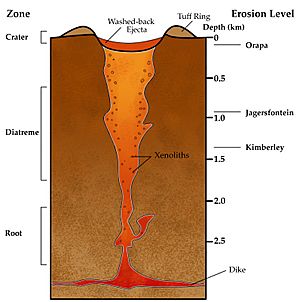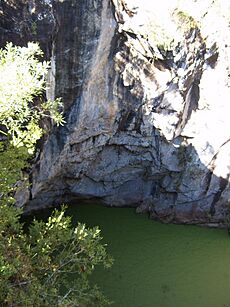Volcanic pipe facts for kids
Volcanic pipes, also known as volcanic conduits, are deep underground rock formations created by powerful, super-fast eruptions from volcanoes that start deep within the Earth. Think of them as the "plumbing" of a very deep volcano.
These pipes are shaped like a long, narrow cone, similar to a carrot buried upside down. They are usually made of two special types of rock: kimberlite or lamproite. These rocks come from deep inside the Earth's mantle, a place rich in a mineral called magnesium.
Volcanic pipes are famous for one main reason: they are the primary source of the world's diamonds! Miners dig deep into these pipes to find these precious gems. While pipes that contain diamonds are quite rare, the general type of volcanic structure they belong to, called a diatreme, is very common.
Contents
How Do Volcanic Pipes Form?
Volcanic pipes are born from extremely violent eruptions. The volcanoes that create them are not like regular volcanoes. Their magma (melted rock) comes from a source at least three times deeper than most other volcanoes.
This deep magma is full of magnesium and trapped gases, like water and carbon dioxide. As the magma rushes towards the surface, the pressure around it drops. This sudden drop in pressure causes the trapped gases to expand instantly, like opening a fizzy drink can after shaking it. This massive gas explosion blasts the magma and surrounding rock upwards at supersonic speeds—faster than the speed of sound!
Types of Volcanic Pipes
There are two main types of volcanic pipes, based on the kind of rock they are made of.
Kimberlite Pipes
Kimberlite pipes are the most famous type because they are the world's main source of diamonds.
When a kimberlite pipe erupts, it blasts a column of rock and magma straight up. It doesn't build a tall, cone-shaped mountain like you might picture for a volcano. Instead, it creates a bowl-shaped crater on the surface. Around the edge of this crater is a low ring of erupted material called a tuff ring.
Over a long time, wind and rain can wear away the tuff ring, and the loose material falls back into the crater, eventually making the ground level again. Besides diamonds, kimberlite pipes can also contain other beautiful gemstones like garnets and spinels.
Lamproite Pipes
Lamproite pipes form in a similar way to kimberlite pipes, but with a key difference. The hot water and gases in lamproite magma are very corrosive, meaning they can dissolve and eat away at the surrounding rock as they blast upwards.
This creates a much wider, funnel-shaped cone underground. This large cone gets filled with volcanic ash and other blasted materials. Finally, the last of the magma pushes up and hardens inside the cone. From the surface, a lamproite pipe often just looks like a flat area of volcanic rock.
See also
- Udachnaya pipe
- Elliott County Kimberlite
- Lake Ellen Kimberlite



